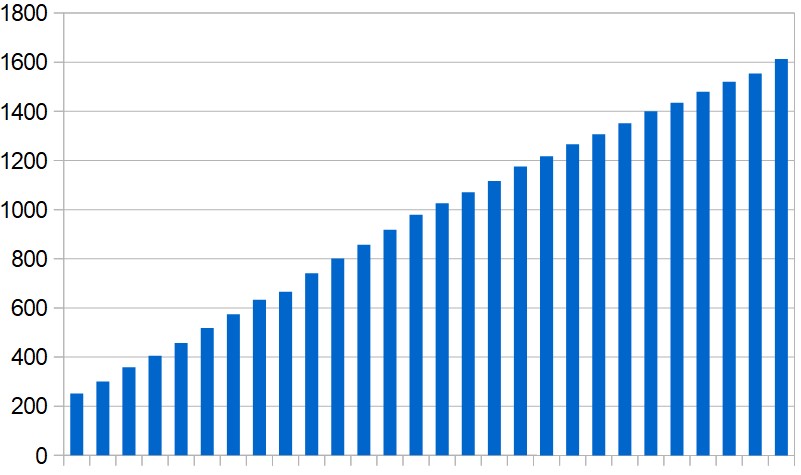Worldwide, more than three million people are now known to have been infected by the Covid-19 coronavirus. Among those, slightly less than two million are currently recorded as "active" cases – the numbers are reduced by people recovering or, in some cases, dying.
Changes in the number of active cases are one indication of what is happening on the ground. When they increase the virus is spreading and when they fall the virus is receding.
Looking at active cases in the Middle East and North Africa region we can see some wide variations.
The table below shows active cases in each country on Monday (as reported by Worldometer), and the percentage change since the previous Monday.
| Country | Active cases |
Percentage change |
| Sudan Qatar Saudi Egypt UAE Oman Kuwait Bahrain Morocco Algeria Iraq Libya Tunisia Lebanon Israel Syria Jordan Iran Palestine Yemen |
232 10,168 16,136 3,209 8,295 1,657 2,254 1,497 3,263 1,527 470 41 695 541 8,468 26 100 14,733 257 0 |
+222% +87% +81% +48% +42% +42% +39% +34% +30% +24% +5% +5% 0% -2% -12% -16% -25% -27% -31% -100% |
These figures need some interpretation but the broad picture is that the epidemic continues to grow in the Arab states of the Gulf (especially in Qatar and Saudi Arabia) and also in three North African states – Egypt, Morocco and Algeria.
On the other hand, there are signs it is subsiding in Iran, Israel, Palestine, Jordan and – possibly – Syria.
CLICK HERE to jump to regional updates
In the middle are four countries – Iraq, Libya, Tunisia and Lebanon – where the past week has shown little change.
The two outliers in the list are Yemen and Sudan. Yemen achieved a 100% reduction in active cases because the only person known to have been infected recovered during the past week.
Similarly, Sudan's 222% increase is not particularly meaningful. The total of known cases there is still small (but growing rapidly) and the outbreak is too recent for many people to have recovered.
The figures for Libya and Syria are also based on a small number of cases and have the potential to rise dramatically in the event of an outbreak among the many people displaced by armed conflict (see previous reports here and here).
In Egypt, Morocco and Algeria it's clear from the increases that transmission is occurring within the community – most likely because of undetected cases spreading infection.
The Arab countries in the Gulf are trying to reduce undetected cases through increased testing – which raises the number of active cases initially, though it should lower them eventually by reducing the potential for further transmission.
At present, the Gulf's main problem is the spread of infections among migrant workers – because of their crowded living conditions.
In countries where the epidemic is clearly subsiding – Iran, Israel, Palestine, Jordan – the need is to get infections down to a level that can be managed without serious social and economic disruption.
Jordan, where the outbreak was never very large, now seems to have reached that point. Over the last couple of weeks it has kept new infections down and reduced the number of active cases by careful monitoring of people entering the country and tracing the contacts of anyone who becomes infected inside the country.
Regional updates
New cases
A further 4,650 Covid-19 infections have been reported in the Middle East and North Africa since yesterday's update – 991 in Iran and 3,659 in the rest of the region.
This is the first time since March 21 that Iran has reported a day-on-day rise of less than 1,000 cases.
Elsewhere, Saudi Arabia reported the largest number of new cases (1,289), followed by the UAE (1,031).
The list below shows cumulative totals (excluding Iran) since the outbreak began, with day-on-day increases in brackets.
Algeria 3,517 (+135)
Bahrain 2,810 (+163)
Egypt 4,782 (+248)
Iraq 1,847 (+27)
Israel 15,589 (+123)
Jordan 449 (+2)
Kuwait 3,440 (+365)
Lebanon 717 (+7)
Libya 61 (-)
Morocco 4,246 (+131)
Oman 2,131 (+82)
Palestine 495 (- )
Qatar 11,244 (-)
Saudi Arabia 18,811 (+1,289)
Sudan 275 (+38)
Syria 43 (-)
Tunisia 967 (+18)
UAE 11,380 (+1,031)
Yemen 1 (-)
TOTAL: 82,804 (+3,659)

Death toll
Iran reported 96 coronavirus-related deaths yesterday, bringing its official total to 5,806.
Elsewhere in the region a further 59 deaths were reported, making a total of 1,613. Twenty of the deaths were in Egypt and 13 in the UAE.
The list below shows cumulative totals of reported deaths in the region outside Iran, with day-on-day increases in brackets.
Algeria 432 (+7)
Bahrain 8 (-)
Egypt 337 (+20)
Iraq 88 (+1)
Israel 208 (+6)
Jordan 7 ( -)
Kuwait 23 (+3)
Lebanon 24 (- )
Libya 2 (-)
Morocco 163 (+2)
Oman 10 (-)
Palestine 4 (-)
Qatar 10 (-)
Saudi Arabia 144 (+5)
Sudan 22 (+1)
Syria 3 (-)
Tunisia 39 (+1)
UAE 89 (+13)
Yemen 0 (-)
TOTAL: 1,613 (+59)

CLICK HERE for previous updates
For anyone interested: A spreadsheet documenting the new coronavirus cases and deaths reported in the region each day can be viewed here.

 RSS Feed
RSS Feed
